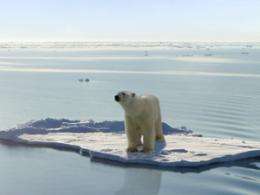Melting Arctic sea ice: How much is down to us?

(Â鶹ÒùÔº) -- Natural climate variations could explain up to 30% of the loss in Arctic sea ice since the 1970s, scientists have found.
Sea ice coverage at the North Pole has shrunk dramatically over the past 40 years. The ice is now more than a third smaller each September following the summer melt than it was in the 1970s. This affects wildlife, while potentially opening up new northern sea routes and controversial opportunities for oil and gas exploration.
Scientists at the University of Reading and the Japan Agency for Marine Earth Science and Technology (JAMSTEC) have found that some of the reduction in ice since 1979 - between 5% and 30% - may be linked to the Atlantic Multi-decadal Oscillation (AMO), a cycle of warming and cooling in the North Atlantic, which repeats every 65-80 years and has been in a warming phase since the mid 1970s.
Dr. Jonny Day, University of Reading, said: "The debate over how much the change observed in Arctic sea ice can be attributed to humans and how much is due to natural variability in the climate is an important one. Our study shows that while natural changes play a significant role, the majority of sea ice loss - between 70% and 95% - is likely to be due to man-made greenhouse gas emissions.
"Work like ours helps to explain how humans and natural variations are affecting sea ice and helps to develop more accurate predictions."
By using advanced statistical techniques to compare satellite data obtained since 1979 with computer simulations run on some of the world's most powerful supercomputers, researchers were able to provide a better estimate of the importance of natural climate variability on the reduction in sea ice, and how much could be attributed to human activity.
They found the natural cycles in winds over the Arctic (the Arctic Oscillation, or AO), which can cause ice to thin in some areas and pile up in others, had surprisingly little influence on the loss of sea ice. However the Atlantic Ocean's AMO oscillation did have an impact.
The research, published online today in , also looks back to 1953 when fewer observations are available. The natural warming/cooling cycles of the Atlantic Multi-decadal Oscillation (AMO) appear to have a much smaller influence on sea ice loss since 1953.
The scientists suggest that their work will help to provide more accurate predictions of changes in sea ice extent, allowing those working in science, policy, industry and those living throughout the polar region to have a better understanding of what the Arctic will look like in the future.
More information: J J Day, J C Hargreaves, J D Annan and A Abe-Ouchi 2012 Sources of multi-decadal variability in Arctic sea ice extent Environ. Res. Lett. 7 034011,
Journal information: Environmental Research Letters
Provided by University of Reading
















